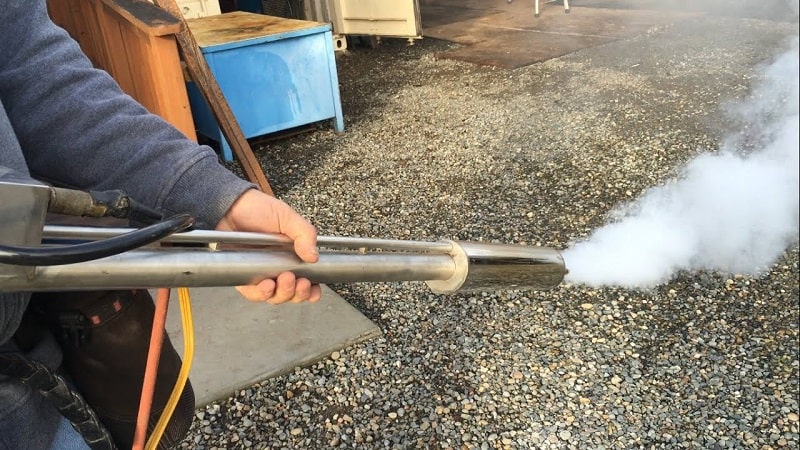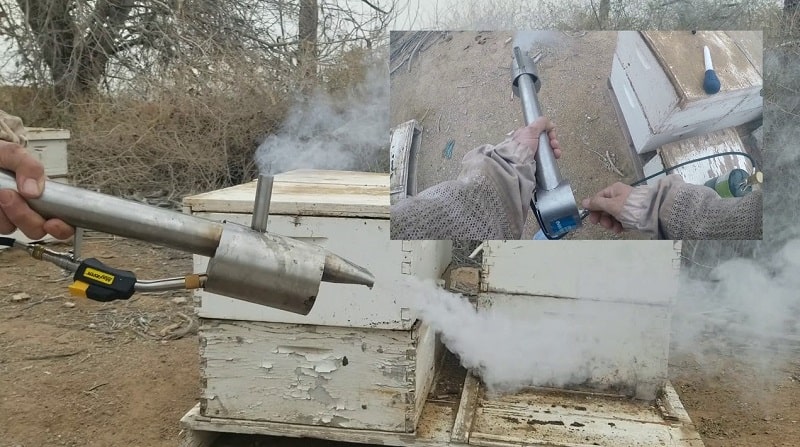Beekeepers utilize a variety of strategies to keep mites at bay in their hives and apiaries. Besides natural Varroa mite control, chemicals like oxalic acid are becoming more popular as miticides. This article will teach you how to use an oxalic acid fogger to treat Varroa mites. Treating mites with an oxalic acid fogger is simple and may be performed by both experienced and inexperienced beekeepers.
What is oxalic acid?
Oxalic acid is completely natural. It is a natural organic substance present in many plants, including vegetables, leafy greens, fruits, nuts, seeds, and others. Herbivores find oxalic acid repulsive, which is useful if you’re a plant!
The oxalic acid molecule is made up of two carbon, two hydrogen, and four oxygen atoms. It is a colorless solid that dissolves in water to generate a colorless solution. In addition to beekeeping, it has a variety of practical applications, including use as a cleaning or sanitizing agent, and mineral cleaning.

What is the process of Oxalic Acid Fogging?
The process of injecting oxalic acid into a beehive using a fogger is known as oxalic acid fogging. Preparing the oxalic acid, setting up your fogger, and preparing the hive for fogger use are all part of the process. You should have all of the necessary supplies and equipment for fogging. You should also have safety gear on hand because breathing oxalic acid is harmful to your health.
Take note of the following:
- Reputable companies employ oxalic acid solutions in their foggers. They leave fewer acid deposits in the fogger. These oxalic acid foggers are simple to keep clean.
- To make your oxalic acid solution, use pure water. This is because you may live in an area with calcium-rich hard water. The calcium in water will react with the oxalic acid, weakening it.
- Some DIY enthusiasts may utilize crystalline oxalic acid in their homemade foggers. They rely on beekeepers’ ingenuity and take a more hands-on approach to beekeeping.
When to use Oxalic Acid to treat Varroa mites?
When there is little brood in the beehive, schedule oxalic acid treatments for Varroa mites. You can also kill the brood during treatments and then replace the brood frames once the mites have been removed from the hive. If your bee colony becomes significantly afflicted during the spring or summer, it is permitted to treat with oxalic acid to prevent Varroa mites from overwhelming the colony.
It is a good idea to keep an eye out for mite drops after oxalic acid fogging. Trapping dead mites allows for an easy assessment of the amount of mites dying. A sticky board at the bottom of the hive works well for this. It allows beekeepers to determine whether or not the medication was beneficial to the bee colony in the hive. Mites are abundant in the first 24 hours following treatment. It then begins to fall over the next few days.
>>> Read more: What happens if you leave honey supers on during apivar treatment
How to mix Oxalic Acid for a fogger?
Oxalic acid is widely available in powder or crystal form. However, this is not an ideal state for usage with most foggers. The oxalic acid must be prepared into a solution that can be placed in the fogger’s oxalic acid container. The usual solution is 25g of oxalic acid powder in 100ml of water. To prepare your oxalic acid fogging solution, you may use either water or ethyl alcohol.
When working with oxalic acid, you should wear protective gloves, goggles, and a face mask as a bare minimum. Bring a plastic or glass container with you that can carry more than 100ml. A stirring tool is also useful. To measure liquids, you will also need weighing tools and a measurement jar or can. It is preferable to increase the concentration of oxalic acid in your fogging mixture in strong infestations. Highly concentrated oxalic acid mixes leave too much acid in the hive, causing injury to the bees.
Follow the procedures below:
- Fill your container halfway with 25 grams of oxalic acid.
- Pour 100ml of ethyl alcohol or distilled water into the oxalic acid.
- Stir the mixture until the oxalic acid is completely dissolved.
- Fill your fogger’s oxalic acid bottle with the oxalic acid solution you just made.
The mixing procedures for hydrous and anhydrous oxalic acid differ. Beekeepers that use trickling to apply oxalic acid to their apiaries must prepare acid solutions. This article is only for using an oxalic acid fogger to treat mites.

Instructions for Oxalic Acid Fogging
Follow the procedures below to use an oxalic acid fogger:
- Drill a hole in the back of each beehive you intend to treat.
- Wear protective gloves, upper body protection, safety goggles and a gas/respirator mask.
- Prepare enough oxalic acid solution to treat all of the beehives in your apiary.
- Fill the fogger’s acid tank with the prepared oxalic acid solution. You can immediately connect the tank to the fogger. Have you thought of getting an extension rod for your fogger? If yes, connect it to the outlet nozzle of the fogger.
- Connect the fogger to the proper propane tank. Ignite the fogger so that it begins to burn propane and heat the fogger’s coil region. For foggers that use electricity, turn on the power source and turn on the fogger to begin heating.
- Work the pump and trigger once the fogger is heated. It should expel a cloud of oxalic acid fog.
- Remove any plugs or stoppers you may have used to seal fogging holes and approach your beehive from the back.
- Replace the stopper used on the fogging hole and apply a puff of oxalic acid fog each beehive. Some beekeepers cover any other openings in the beehive that could allow oxalic acid fog to escape. Remember to take off any coverings you used to seal beehive holes.
- Repeat steps 7 and 8 for every beehive you are treating.
It is conceivable in large apiaries to use up all of the acid solution in the fogger’s oxalic acid tank before treating all beehives. When the oxalic acid tank is empty, turn off the fogger. Before replenishing a propane fogger, you must extinguish the flame. Do not touch the fogger’s coil cover during refilling. After you turn off the fogger, it stays heated for a while.
Oxalic acid fogger vs vaporizer
The use of vapor to deliver oxalic acid into the beehive is an efficient way. It makes use of the physical features of oxalic acid by sublimating it with heat. This necessitates the use of specialized equipment known as vaporizers. An oxalic acid vaporizer is any piece of beekeeping equipment used to heat oxalic acid till it sublimes inside a beehive. Electricity is used to power vaporizers. Depending on the manufacturer, they can operate on both DC and AC power.
The second way of treating Varroa mites with oxalic acid is fogging. It is quite quickly, allowing beekeepers to travel from one hive to the next in quick succession. The major piece of equipment required for oxalic acid fogging is, of course, a fogger. This is a high-temperature apparatus that achieves very quick oxalic acid sublimation. Fogger usually prefers to use oxalic acid in its liquid form. Significant foggers may use oxalic acid crystals, although this has some drawbacks.
Conclusion
It is a good idea to use an oxalic acid fogger to apply oxalic acid mite treatment to your beehive. It allows you to disturb bees as little as possible. Always use protective clothing against both bee stings and oxalic acid. This natural Varroa mite control method allows you to obtain high-quality beehive products while maintaining the health of your honey bee colony. Use this guide to get outstanding oxalic acid fogging results.
Related Posts:
